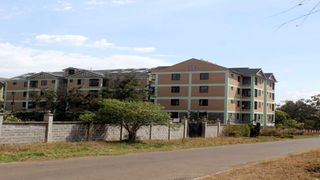
Some in the middle of Milimani estate in Kisumu.
| File | Nation Media GroupKisumu
Premium
Lost glory: The death of Kisumu’s posh estates
Most major towns in Kenya have a Milimani estate, where the rich and mighty who can afford an exclusive and exquisite atmosphere reside.
In Kisumu, however, Milimani is losing its prestige and slowly becoming an eyesore. Poor planning has ruined the once leafy suburb. It’s the same script for Kenya Re, Robert Ouko, Mosque, Tom Mboya and Mountain View estates.
Many middle class residents have moved to the outskirts of the city, such as Riat, Ogango, Kibos, Nyamasaria, Airport and Obambo. A mention of Milimani, some 10 or so years ago, would attract honour as only the rich lived there. Well, not anymore.
There has been an influx of non-governmental organisations renting some of the houses in Milimani for office space. Investors have also turned most of the apartments into Airbnbs.
The estate is dotted with old houses, rundown buildings, kiosks and containers. Unplanned construction of flats has created confusion in Mountain View Estate, Mosque, Tom Mboya and Kenya Re.
Skyscrapers
Kenya Re was originally meant for bungalows and mansions, but there are now skyscrapers. A gated community, it was one of the most posh estates in the 1990s.
In Milimani, it took the intervention of the city management to restore order in the estate, bringing down shanty structures. It’s close to Kisumu’s largest informal settlement, Nyalenda slums.
In 1983, Milimani was zoned as a low density residential area. But over time, the population has increased in the area due to its proximity to the central business district and provision of infrastructural services.
The proposed zoning plan for the estate included the height of buildings, amount of space structures may occupy and the location of a building. Others were proportions and designs of space, such as landscaping, impervious surface, traffic lanes and parking.
The increasing land prices in Milimani pushed the need to maximise on the plots by requesting for more occupancy density to enable investors maximise on the land values.
Existing developments are only up to three floors. The zoning intended to increase the densities up to 12 floors, but the ground covered by this development was expected to be only 60 per cent.
Plot frontage
Developers were also required to adopt the plot frontage and light it up at their cost and surrender a meter to a road frontage to allow future expansion. They were to leave a minimum of 40 per cent open space with grass occupying a minimum of 20 per cent.
Former Governor Jack Ranguma’s plan was to rebuild Milimani with a proposal on incentive zoning that would make it look like Nairobi’s Upper Hill. Governor Anyang Nyong’o’s approach is, however, different as he opts to retain three floors, but include green spaces.
He plans to use the Kisumu City Physical and Land Use Development plan to prevent slum formation through adapted housing supply and zoning. It will also provide land for undersupplied uses, in adapted size and location.
“We recently declined to approve a design by a developer who wanted to construct an eight-storey building in Milimani. We’re restricting it to three floors in line with our city plan,” said acting city manager Abala Wanga.
Mr Wanga said they were working on an urban regeneration programme to fix the mess created through lack of planning in these estates.
Affordable housing
He said their focus is also on affordable housing, which has started in old estates such as Makasembo and Ofafa Anderson. A real estate developer, however, said the issue is about the pricing of properties in the prime Milimani area.
Mr Evans Wayiera of Wayiera Properties Limited, said the high prices have kept away potential investors as kiosks take over parcels left empty. An acre in the posh area costs between Sh100 million and Sh120 million.
This also applies to the old houses occupying prime spaces, whose owners demand millions of shillings.
“Kisumu still doesn’t have high-end developers that can pump that kind of money into such ventures. They would rather go for other locations which cost less and help them save a lot,” said Mr Wayiera.
He gave an example of the hilly and rocky suburbs of Riat or Polyview Estate, where an acre costs Sh30 million. One could use the remaining Sh70 or Sh90 million to construct an apartment block with 20 to 30 units.
“Milimani should be fully commercialised to create space for expansion of the town, since as it stands, the pricing issue may still keep investors away,” he said.
Land grabbing
Land grabbing is also a major issue affecting these estates. The county government last month wrote to the National Land Commission (NLC) seeking to repossess land, institutional houses, pathways, markets and industrial parks grabbed by former top Kanu politicians who served in former President Daniel arap Moi’s government.
A letter written by Mr Nyong’o lists 120 individuals implicated in the grabbing of the properties, delaying plans for implementation of development projects, including the Social Economic Zone (SEZ).
In 2015, a report on irregular and multiple allocation of public land in Kisumu revealed that over 62 institutional houses in Milimani had been grabbed by powerful people in Nyanza. The report also recommended the investigation of 27 plots in other blocks of the city.





